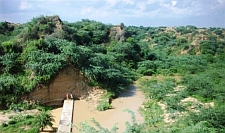Saturday, April 20, 2024
News and Views from the Global South
ENVIRONMENT-INDIA: Fighting Drought With Check Dams
Ranjit Devraj
- Gazing out at the lush greenery that surrounds the village of Salaita in northern India, a smile of satisfaction appears on retired army general A.P.S. Chauhan’s face.

One of the simple check dams that transformed Salaita from a dusty village to a lush refuge in the Uttar Pradesh ravines. Credit: Ranjit Devraj/IPS
In recent years, large tracts of land along the river Yamuna had eroded so much that they appeared like a series of deep serrated ravines. The cover of vegetation that would have retained rainwater and held intact the light alluvial soil had disappeared.
Deforestation and ill-conceived irrigation projects added to the problem of droughts in this region, also called Doab — the land of the two rivers: Yamuna and Ganga — which is one of the world’s most thickly populated areas. This reduced the fertility of the soil and its ability to sustain millennia- old agriculture.
Uttar Pradesh, a state with 190 million people and larger than many nations, is estimated to have lost 3.5 million acres of productive land through this phenomenon called ravine erosion.
More than four years ago, when Chauhan’s Sainik Foundation, a non- government organisation formed by retired army personnel, decided to do something about the situation in Salaita and the neighbouring Jabrapura village, it was confronted by myriad problems such as endemic corruption, bureaucracy, and the lack of a local knowledge base.
“On the plus side,” said Chauhan, “we could draw upon the experience, loyalty and support of retired soldiers in these villages that are home to 400 families.” Joining the army is a coveted profession in these parts of north India.
Soon thereafter an action plan was drawn up with check dams at the heart of the solution.
“The results were dramatic,” Chauhan told IPS. “We succeeded in arresting 80 percent of the water run-off from about 40 hectares of catchment area that fed into the Yamuna river from its north bank, and the underground water table rose by about 24 ft where it is now being maintained.”
With water supply secured, it was possible to plant some 5,000 trees and build grazing grounds over 10 hectares of reclaimed ridges and gullies. By recharging the water table it was also possible to save up to 60 percent of the costs involved in getting the land ready for cultivation.
Sanik Foundation is currently building its third check dam in the area, which is now nearing completion.
The low-cost community-owned check dams and water harvesting structures demonstrate the ease with which villages can be drought-proofed and long- dead wells can be revived.
After the check dams, crops of mustard, wheat and coarse grains began to grow in the village fields, providing food security, employment and much- needed cash to villagers. A grove of shisham (Indian rosewood) trees coming up in the area provides shade and wood.
With higher moisture content in the atmosphere around the villages, other income-generating activities such as bee-keeping became possible.
But the most significant change, Chauhan says, was the coming together of a core of committed people from the community with experience in rural technologies and agro-forestry to execute the micro-project to sustain themselves without any outside help.
Villagers recall how Salaita village had become so ravaged by ravines that it had become impossible to take a walk through it.
“The land could no longer support agriculture, the pastures had vanished, and there was no work available. The village roads had become pitted and so full of potholes that it was beginning to affect our social life,” village leader Mahendra Man Singh told IPS.
Singh, a retired army sergeant, said that when the project was being discussed five years ago, few were convinced that it would be possible to build check-dams on the loose sandy soil. “We were in such a plight that hand pumps that reached to depths of 190 metres had ceased to work because of the receding water table.”
Chauhan recalled that during one of his early visits to the village, an old widow begged him to kill her. “There is no water in the village and the politicians just come here to ask for votes, she told me,” Chauhan said.
But the first community built check-dam changed that situation. Within six months, the dried up wells were brimming with water. Tube wells were working at 20 ft where they had failed at depths of 190 ft.
Chauhan recalls that the villagers were also initially suspicious of the idea of reclaiming ravines through “contour bunding and planting vegetation” rather than leveling, which is costly.
“But once we came in armed with funds (about 50,000 dollars) from the Global Environmental Fund (GEF) under the United Nations Development Programme, the villagers realised that we meant business,” Chauhan said.
“To be frank we could also leverage support from other entities. For example, whenever there was a real need for heavy equipment like bulldozers we could always leverage Sainik Sangh’s connections with the army,” said Chauhan.
The GEF, through its small grants programme, supports initiatives such as the one at Salaita. It demonstrates how a community-based innovative, gender sensitive, and participatory approach can diminish threats to the local and global environment.
Ownership of the water-harvesting structures and the funds helped build confidence and trust. “The villagers were impressed by the fact that no one could withdraw any of the funds coming in from the GEF and other sources without their representatives signing up,” Chauhan said. “This was a distinct departure from the cryptic ways of the local administration.”

 Print
Print



